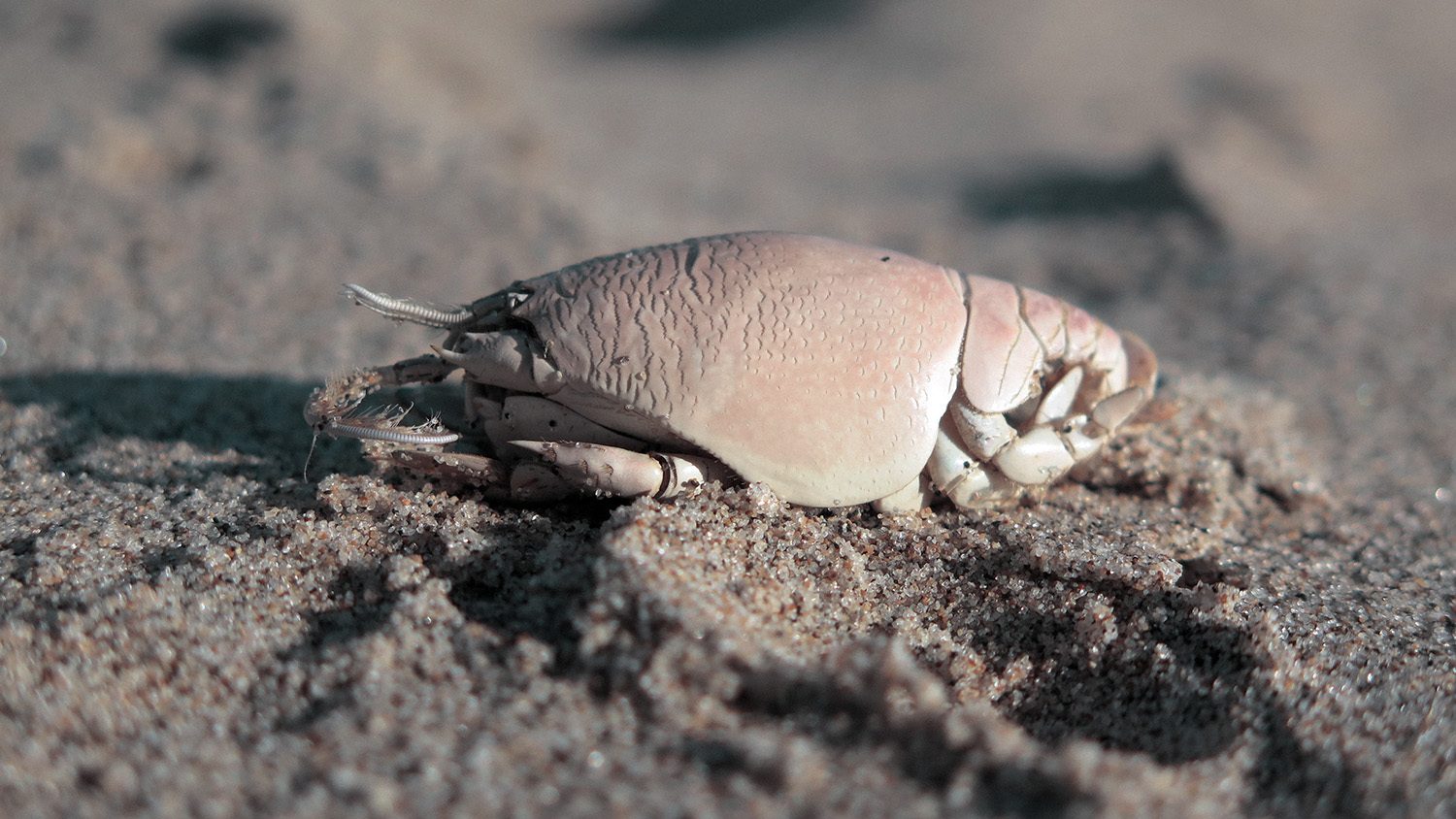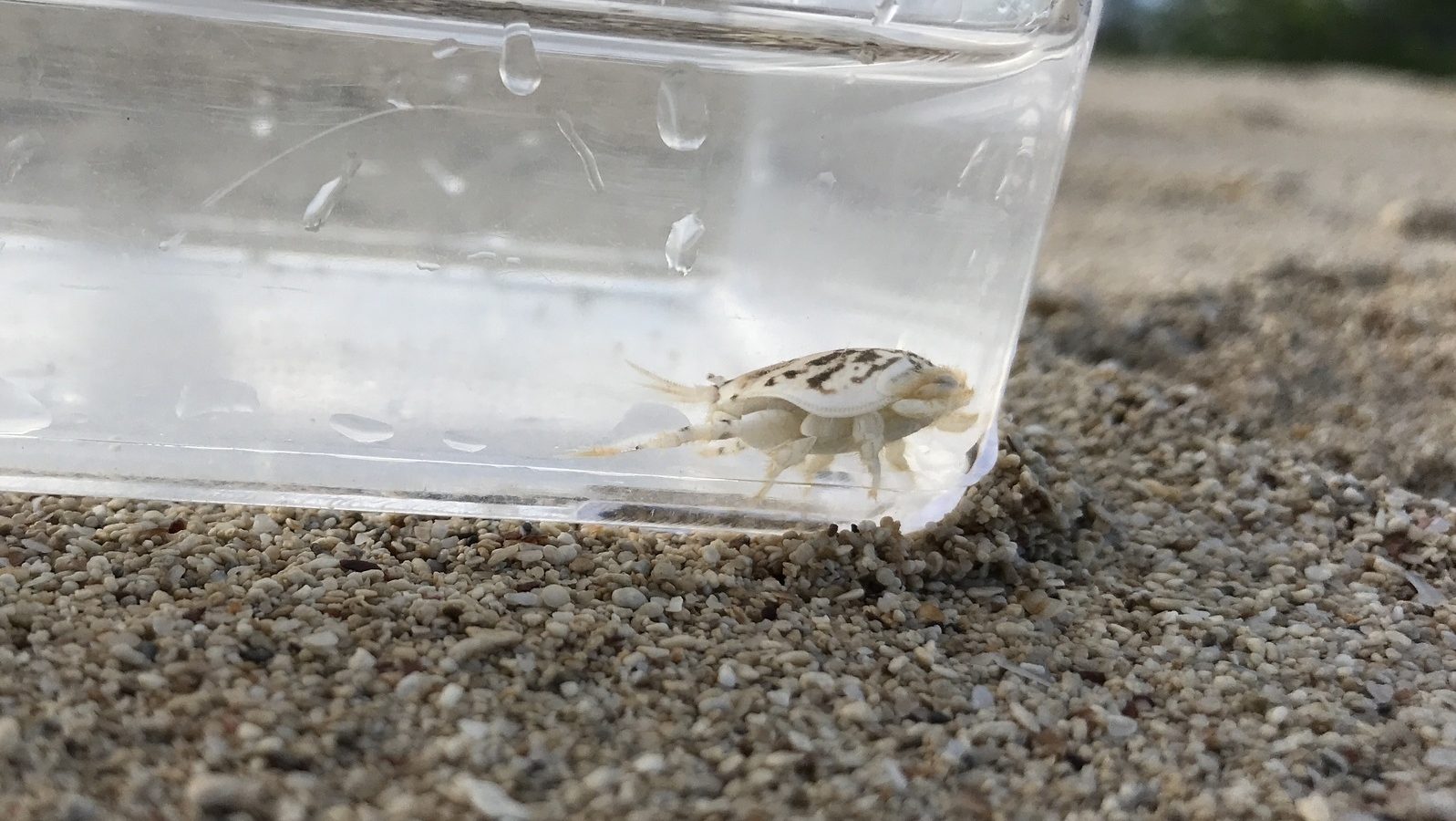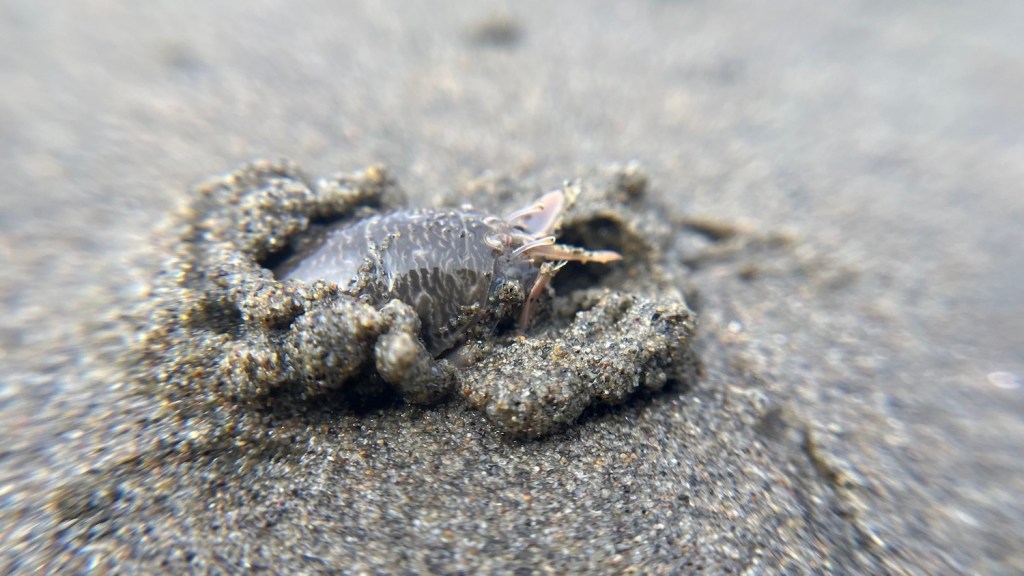My young son and I dug with our plastic shovels, fortifying the sand castle against the oncoming tide. In one scoop, my son gave an excited yell of surprise. He swiveled to show me the creature perched on his shovel.
To me, this animal has always resembled a fat shrimp that has lost most of its tail. Or perhaps, a supersized sowbug.
We admired it briefly, then placed it back down in the sand. In a blur, the creature dug backwards and disappeared, leaving only a dimple on the surface as evidence of its existence.
We had encountered a mole crab, a crustacean that is incredibly common on the Atlantic and Pacific coasts of the United States, as well as on other beaches in many parts of the globe.
You may have caught brief glimpses of these creatures as they frantically burrowed into the sand as they were exposed by incoming waves. Or perhaps your kid also dug one up while build castles.
It may be one of the more common beach creatures, but few take the time to learn more about them. Mole crabs have fascinating life histories, they’re important to coastal ecosystems and kids love them. Let’s take a closer look.

Meet the Mole Crab
Mole crabs are crustaceans in the family Hippidae, found in nearly every coastal region of the world except the Arctic and Antarctica. Twelve species in the genus Emerita are abundant on the Atlantic and Pacific coasts of the United States, as well as the Caribbean, South America, east Asia, southeastern Africa and Madagascar. Mole crabs in the genus Hippa are found in Indo-Pacific region including Australia.
They’re often commonly called sand crabs, sand fleas and sand bugs. The common names indicate this creature’s notable habit of burrowing in sand. They don’t get large, with a big one about the size of your thumb.
The mole crab does not look like our usual image of a crab. It lacks claws and that familiar crab shape. It has a oval body that many describe as “barrel shaped.” It may look like a simple creature at first glance, but look closer.
It has a tail-like appendage called a pendula that is important for digging. They have feathery attenae that filter plankton as it washes over them. Both of these features give cluses as to the mole crab’s life: this is a creature adapted to living where waves break.

Life in the Swash
Mole crabs live just under the sand where they filter plankton. You might think this would not lead to a very action-packed lifestyle, but you’d be wrong. The mole crab’s life is one of frequent movement and adjustment…often frantically so.
Mole crabs live exclusively in the intertidal zone, an area often called the “swash.” This is where waves crash on the beach, the place where kids love to play and you may enjoy taking an early-morning walk.
Obviously, tides shift, so mole crabs are constantly undertaking mini-migrations so that they stay in the swash zone. Quinton White, executive director of Jacksonville University’s Marine Science Research Institute, notes that “the population in a given area of the beach is sorted, with the larger animals in the lower portion of the swash zone and the smaller ones higher on the beach.”

With its life in a zone of crashing waves, the little mole crabs are often exposed, making them vulnerable to predators. And here’s where the mole crab’s most fascinating adaptation comes into play: the ability to burrow. Rapidly.
Research has found that a mole crab can bury itself in one second. They’re gone in a flash, so it’s difficult to observe what’s going on. Mole crabs dig backwards, using their pendula to, as the PBS program Nature puts it, “vigorously beat the wet sand with their tails, whipping it into a semi-liquid state.”
It then uses its legs to push the sand to the surface. The Nature episode on mole crabs, featured below, has great footage of mole crabs in action as well as a deep dive into the science.
Female mole crabs are considerably larger than males. When a female lays eggs, the smaller male will often attach itself to the underside of the pendula. Here it can live in a semi-parasitic state until it outgrows its unconventional home.
After the mole crab has disappeared, it often leaves only a little bubbling air hole or dimple as a clue to its presence.
Mole Crabs on the Menu
Mole crabs often live in large colonies and are an important food source for many species. On beach walks, you likely have noticed shorebirds running with the waves, looking much like children do when they’re playing in the water. Many of them are actually chasing exposed mole crabs. It’s why the mole crab must bury itself so quickly. To be above the sand is to quickly become a bird’s meal.
Sanderlings in particular can be seen darting amongst the waves and poking their bills into the sand, on the hunt for mole crabs. Willets, godwits, blackbellied plovers and other shorebirds also hunt these crustaceans, as do opportunistic gulls and egrets.
They are also consumed by fishes in the intertidal zone. The barred surfperch of the Western U.S. coast is a mole crab specialist, with the crab making up about 90 percent of its diet.
My friend and fishing writer Steve Ramirez says that to effectively fly fish for corbina, a bottom-feeding fish of the Pacific Coast, you need to know sand crabs. In his book Casting Seaward, he writes “As corbina anglers we need to look for ‘crab beds’ where many of these little creatures have gathered because that space on the beach favors them in that moment of time and tide. If you watch closely as a wave is receding over them, you hmay see the crabs uncoil a second pair of featherlike antennae which they use to filter out tiny plankton that they feed on.”
Ramirez believes that to be a good angler, you have to be a good naturalist. I agree, and I think the same goes for any beachgoer. To get the most out of the experience, you should stop and notice the mole crabs.

Mole Crabs Under Threat
Mole crabs are abundant on many beaches. But there are signs that their populations are declining in places. Because they feed on plankton, they’re an indicator species of coastal health. They may be susceptible to ocean acidification and mole crabs exposed to microplastics exhibit higher levels of mortality.
Direct impacts to beaches may be an even bigger threat. Dredging and the practice of adding sand to the beach (to counter erosion and improve conditions for tourists) may impact crab populations.
Recent studies also suggest that mole crabs decline in areas of especially high human usage, such as urban beaches and those that allow off-road vehicles. This may be more due to pollution than people walking on the beach.

To Catch a Mole Crab
Fortunately, mole crabs are common at many popular beaches around the world. And because they do not pinch or bite, they are a great creature for kids to catch and release. I enjoyed chasing them before they burrowed as a youngster, and admit I still get a kick out of observing them today.
And yes, I know mole crabs face threats, but they are an easy species to catch, observe and set free. I think up-close and personal encounters with wildlife can inspire a lifelong love of the natural world and conservation, with minimal impact.
Catching a mole crab is a low-tech affair. You don’t even need a little dip net. You can watch where the waves break and try to snatch one before it burrows. (Good luck). Or you can watch one disappear and then lightly dig it up. They don’t dig deep, so you don’t need to scoop much sand.
Pick up the mole crab, rinse it off and look at its antennae, legs and pendula. If it’s a larger-sized specimen, flip it over and see if a male crab is catching a ride.
Then put the little creature back on the sand (make sure it’s in the intertidal zone) and watch it burrow away in a swirl, as if it was never there.
Keep looking, and you’ll see the signs of them everywhere: their little breath holes, their scurrying bodies in the swash and in the beaks of feeding shorebirds.




Oddly enough perhaps, I grew up on Atlantic beaches that had too high impact littoral zones for mole crabs, so I was in my late 40s before I “discovered” them during a summer biology stint on Nantucket. Fascinating critters that fit right in with my American Oystercatcher feeding ecology study.